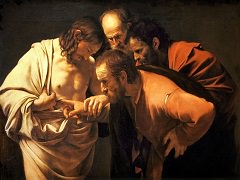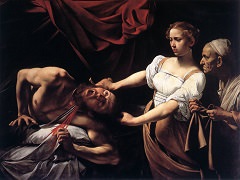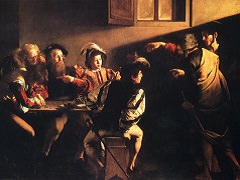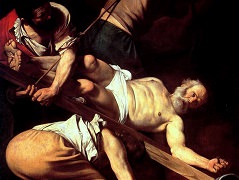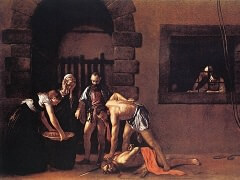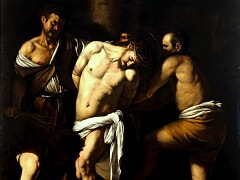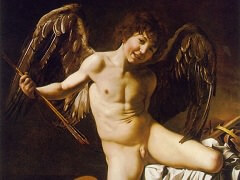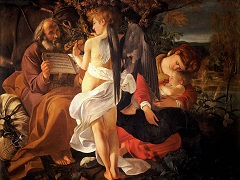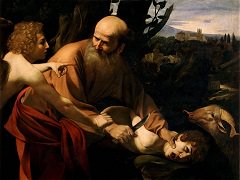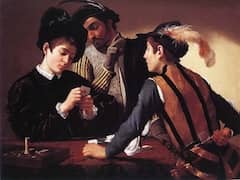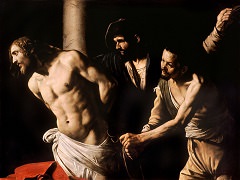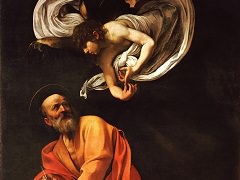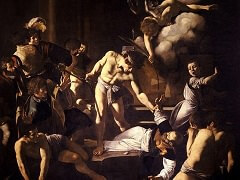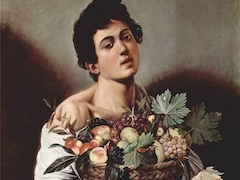Caravaggio and his paintings

Caravaggio was probably the most revolutionary artist of his time, for he abandoned the rules that had guided a century of artists who had idealized both the human and religious experience. He can be said almost
single-handedly to have created the Baroque style.
Michelangelo Merisi da Caravaggio, known as simply Caravaggio, was born in Milan, and his father worked as an architect for the Marchese of Caravaggio; his mother Lucia, was from a family in the same district. In 1576, to escape a plague in Milan, the family moved to
Caravaggio; here his father died in 1577 and his mother in 1584. In 1584, he was apprenticed, for four years to Lombard painter, Simone Peterzano. Upon his apprenticeship ending, Caravaggio remained in the area. Here he became familiar
with the works of Leonardo da Vinci, Michelangelo, Titian, Raphael,
and other High Renaissance masters, which were popular in the area.
In 1592, Caravaggio fled Milan, and moved to Rome; he did not have money upon his arrival to the city. A few months after the move, Caravaggio began working for Giuseppe Cesari, where he paints flowers and fruit in Cesari's factory. In these works,
Caravaggio depicted signs of realism, which he would focus on during his whole career.
In 1954, following the end of his working career with Cesari, Caravaggio was determined to make his own way and make a name for himself. It was during this period that he made several friendships with Prospero Orsi, Onorhio Longhi,
and Mario Minniti, all of who worked in the art world. These men not only introduced Caravaggio to others in the art world, but also helped him put his work out in front of others, to gain more fame in this field.
Caravaggio's paintings are known for their intense realism and the use of strong contrasts of light and dark, known as chiaroscuro. He was one of the first painters to use this technique, which became a defining characteristic of Baroque art. He also used everyday people as models for his religious and mythological scenes, giving them a sense of realism and immediacy.
The Fortune Teller was Caravaggio's first major piece; it showed Mario being cheated on by a gypsy girl. This was a new style to Roman artists, and the style helped pave the way for changes that came in Roman art in the coming decades. However, this oeuvre was sold for a very low price.
One of Caravaggio's most famous paintings is The Calling of Saint Matthew, which is located in the Contarelli Chapel in the Church of San Luigi dei Francesi in Rome. The painting depicts the moment when Saint Matthew is called by Jesus to become one of his apostles. Caravaggio used a real-life tax collector as the model for Saint Matthew, which adds to the realism of the scene. The use of strong contrasts of light and dark in the painting helps to create a sense of drama and movement.
Another famous painting by Caravaggio is The Crucifixion of Saint Peter, which is located in the Vatican. This painting shows the moment when Saint Peter is crucified upside down, as he requested, because he felt unworthy to be crucified in the same way as Jesus. Caravaggio's use of chiaroscuro in this painting helps to create a sense of depth and emotion. The dark background contrasts with the bright light illuminating Saint Peter's face, which shows his pain and suffering.
These, and several other pieces Caravaggio created during this period, helped pave the way for his career, and helped create a name for himself in the art world. Caravaggio was later given several contracts to do work throughout several
chapels in Rome, as well as in neighboring cities. For the most part, these new paintings, and each new job he took, helped to increase the fame which Caravaggio was experiencing during the time; however, there were a few of his pieces
that were rejected for the foreign style, and the distinct style which was not well appreciated by all in the art world during this period. To some, the dramatic intensity in the work Caravaggio created, seemed quite vulgar, and was well beyond
what was acceptable during his time.
Many of Caravaggio's paintings dealt with death, as well as sexual depictions, which the church would not stand for; for this reason, many of the oeuvres that he created during this period, were viewed as vulgar. Some of the works he is
most well known for during this period include The Madonna of the Grooms, and the Death of the Virgin, which was commissioned in 1601. Although many
rejected his work, the theme and styles Caravaggio chose to work with, meant his work was also visionary for the time, as no other artists were willing to complete similar depictions.
Painters' lives seldom generate glamour, scandal, or romance on anything like the same scale as literary biography. Van Gogh was one exception. Picasso
was another. Caravaggio is a third. Caravaggio led an extremely notorious life; he was well known for constantly brawling and getting into arguments, not only with peers in the art world, but also with police and other authorities.
He had an extensive trial record, and an extensive police record, due to the disorderly conduct, and the manner in which he conducted himself when in public. In 1606, Caravaggio's violent behavior culminated in a duel with his romantic
rival Ranuccio Tomassoni. The artist pierced his opponent's femoral artery, and Tomassoni died shortly thereafter. The outcome is that Caravaggio was outlawed from Rome, and he made his way to live in Naples. Here he was protected by
the Colonna family; once the most famous painter in Rome, Caravaggio was now the most famous painter in Naples.
The connection he had with the Colonna family, allowed him to get hired for a series of commission works, that were to be done throughout a series of churches in Naples. In 1608 he was again arrested, for a brawl, and was exiled
to Sicily. The details surrounding Caravaggio's final days are sparse for a man who led such a turbulent life, but most scholars agree that the painter died in Tuscany in July 1610.
Caravaggio's paintings had a significant impact on the art of his time and continue to be admired today. His use of realism and chiaroscuro helped to create a new style of painting that came to be known as Baroque. His influence can be seen in the work of many later painters, including Peter Paul Rubens, Rembrandt, Johannes Vermeer, and Diego Velazquez. Although Caravaggio had a tumultuous life and career, marked by legal trouble and violent death, he played a key role in defining 17th century Italian art, and his paintings continue to be celebrated for their emotional power and technical mastery.

